【SaaS Inbound Marketing Guide: Website Case Study – Auto-Acquire Customers】
One of the hardest part for startup SaaS is acquiring new customers. Today we are going to discuss some key features you can have in your SaaS website to assist your visitor on their conversion path. We will also dive deep into a case study with SaaS brand Zapier’s example demonstrating how does everything work well together.
SaaS Inbound Marketing
Website Case Study – Zapier
Zapier is a SaaS company that creates automation within more than 2,000 digital apps, to simplify the repetitive tasks without complex coding or developers. The simple interface allows almost anyone to control and setup with ease, and have attracted over 3 million people ever since 2011. Their website is well made for both acquiring newcomers and nurturing current customers.
Learning about your
SaaS business
One key factor on a SaaS website is to introduce visitors with their new technology concepts. SaaS company is usually providing a relatively new solution to get things done. Your visitors may be unfamiliar with the concept you are proposing, or not even recognize they have a need. For cases like this, the learning curve might be steep and overwhelming to this large group of the potential customer.
That’s why education is important on a SaaS website: assisting the visitors to leap from their current method, to the place where your service helps them.
Starting Inbound Marketing with familiar grounds
A common approach to your visitors is starting from their current position. You can introduce the new concept by letting the visitors absorb information that they can relate to, solid grounds that they understand, and then give them a demonstration on how your service can help improve. Think of this as building a bridge from their end, and step by step incorporate how your service works better in the situation they are in.
However, everyone has a different thinking path, and providing the same path for everyone might make it difficult to keep up with the logic behind. Therefore, you need more information from the visitor to provide the information they can resonate with, and a better visitor experience using inbound marketing.
Creating experience and content tailored to a specific group is a key feature of inbound marketing.
From our example, Zapier, there are several routes for visitors to get started. They can choose to learn about how their service helps them from their job role perspective, or they can start with the other digital apps they are using.
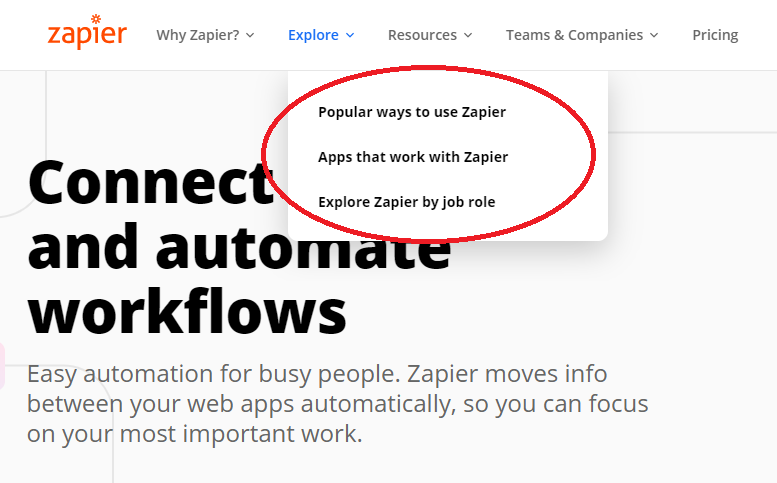
Source: Zapier Website
Personalise with Job Roles / Work type
No matter what of your target market is, there is always multiple application to your service. One way to segment the visitor route is by their job roles, since there are likely to have a different application of your service to each workforce. Visitors from diverse fields might be using varying tools that do not apply in other industries, or have a completely unrelatable scenario.
Upon clicking the “Explore Zapier by job role” button on the menu, you are referred to a page with listing of different workforces. Keep in mind that you do not need a segment for all job titles, but group them under similar purpose or application.
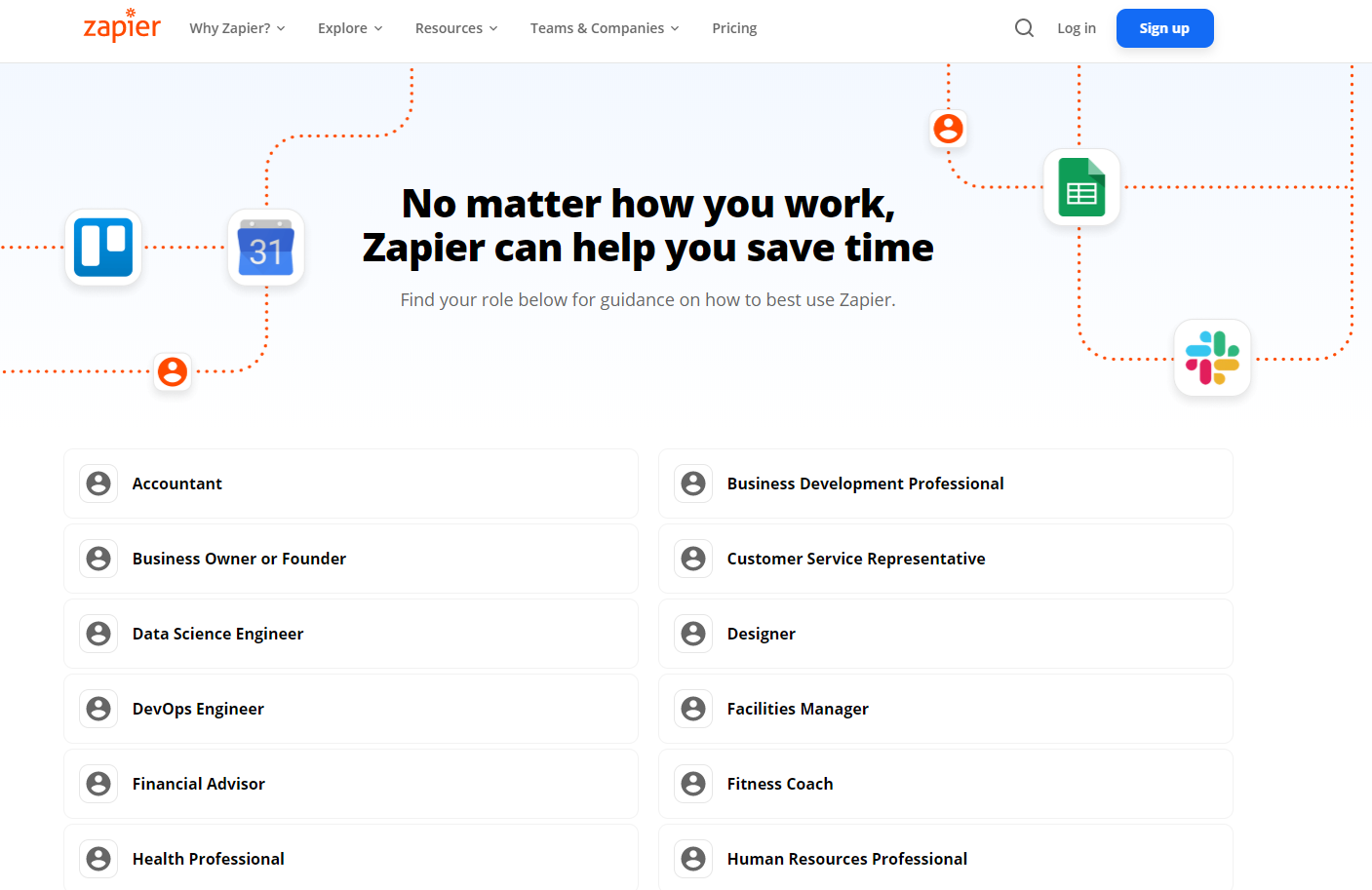
Source: Zapier Website
For those choosing the job segment route, Zapier provides a demonstration of automations base on a common selection of apps and automated functions by their current customers. Here we can see that the suggestions for designers and project managers contain individual sets of apps, and the automations serves varied purposes.
For comparison, designers might need apps related to illustrations, brainstorming, mood boards, social media…
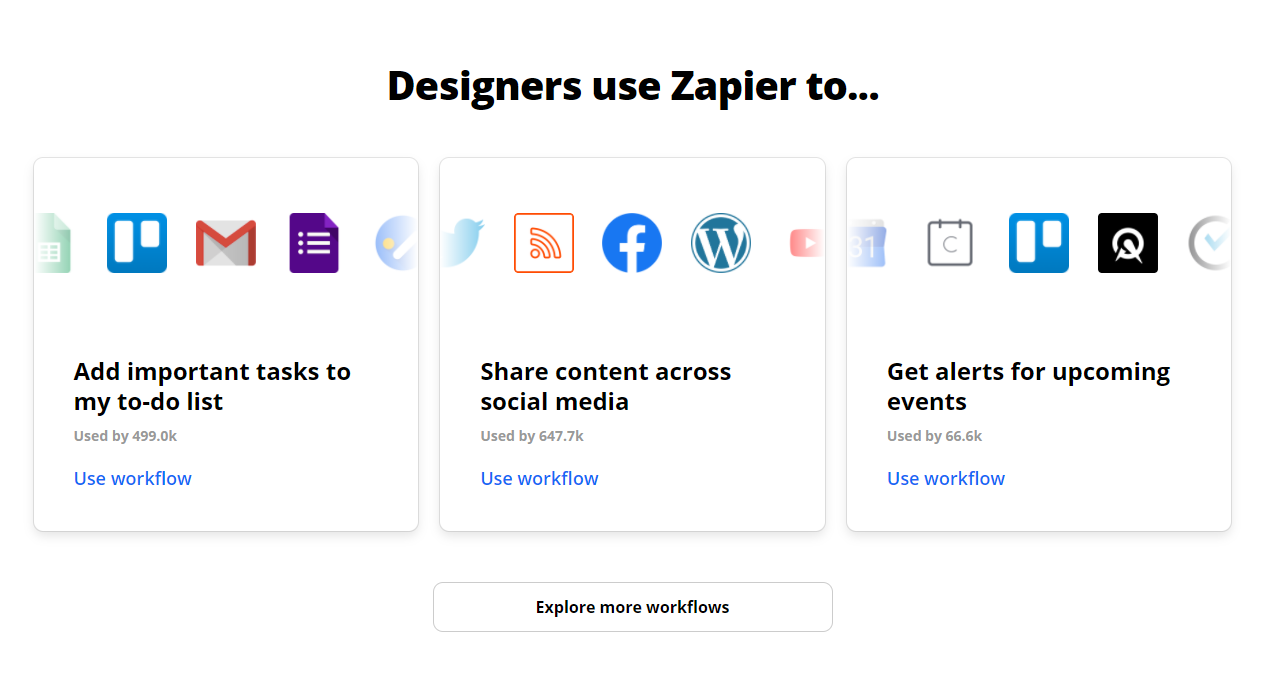
Source: Zapier Website
...while product managers would like to schedule meetings, analyze sales data or sending automated emails.
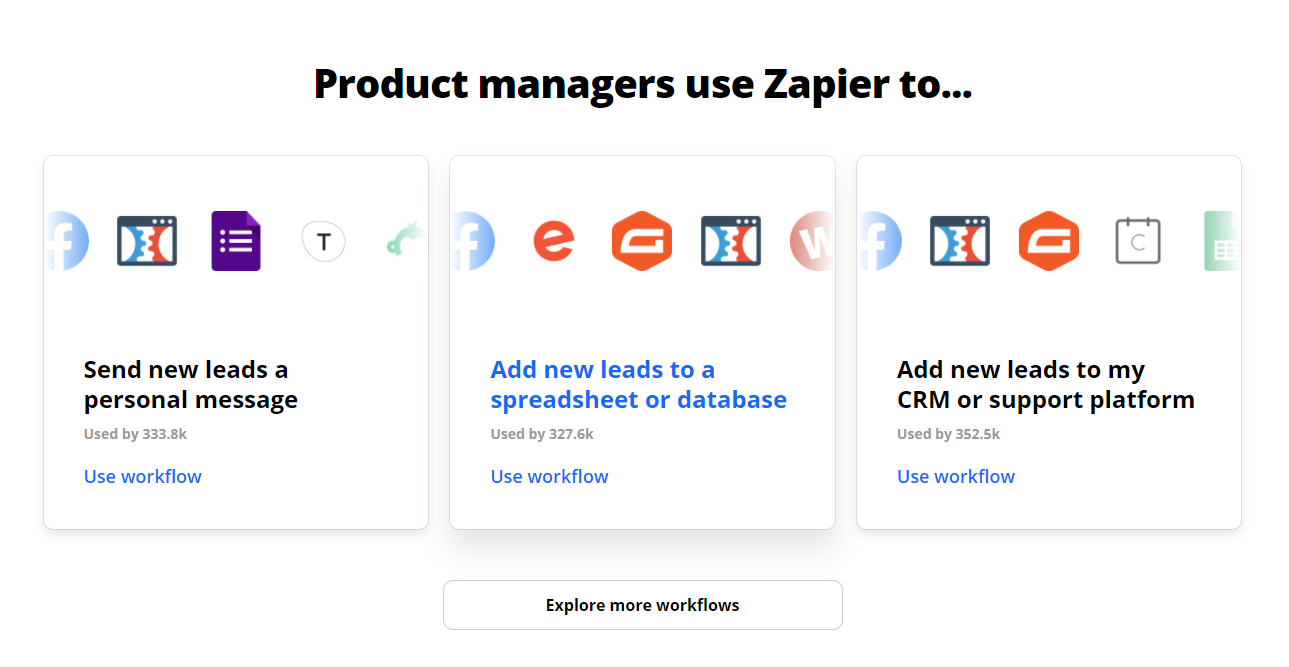
Source: Zapier Website
This structure not only allow the visitor to have a personalized browsing experience, with content closer to their particular needs, it also helps Zapier to understand and segment their visitors better without the obvious way of requiring the customer to fill out a form. This would give a better perspective of who are the visitors and main pain points of these visitors, and create matching inbound marketing content for them.
Personalise with Their Current Practice
Another route is to start with asking them how are they currently operating. They are likely to have a method that is working fine for now, but you want to give them a new way to simplify their job. Asking for how they are working and try explaining base on their current practice shows them a better option, and they can resonate well with your information.
For Zapier’s case, the visitors are likely to be using several apps to help them work. They can look up the apps they are currently using, and Zapier will come up with templates they offer. The suggestions are highly personalized, as each visitors might have a different repetitive task they want help with.
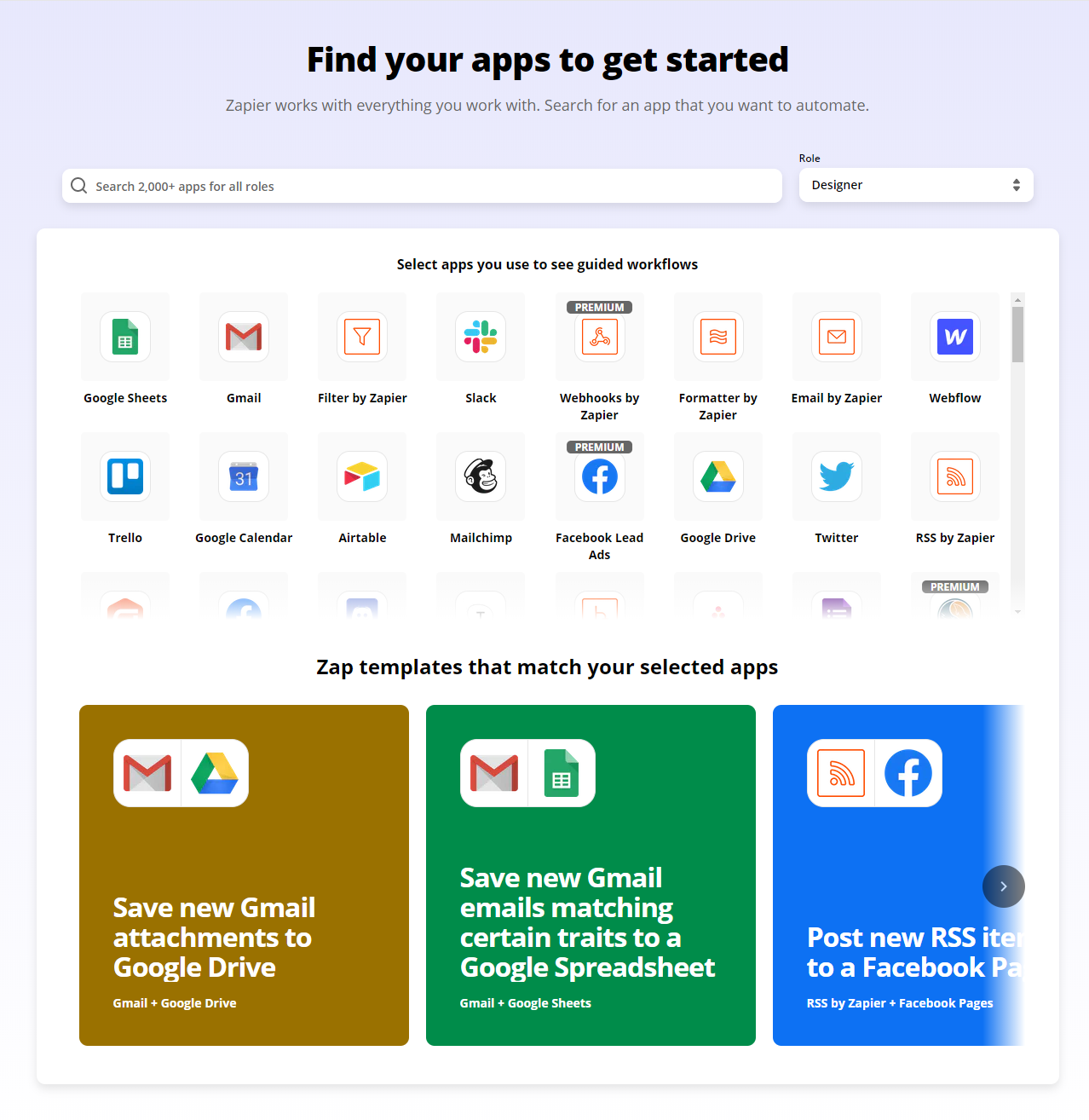
Source: Zapier Website
Mindset Introductory Contents
Another common way of encountering your brand through website is when they are searching for ways to improve on their current work style. You can write blogs about a lifestyle that matches with your brand or product's big idea, without hard-selling your service right at the front. This is a persuasive practice to apply in SaaS inbound marketing, as you are creating content leading your visitors to resonate with your morals and intention of creating the product or service. The group of similar minds you attract will have a high chance of being potential customers of your service!
Since Zapier is all about efficiency and focusing on the important things for your work, they have a section labelled “Productivity”, promoting the work style that fits with Zapier’s mindset. A wide range of content is listed under this category, from advising on how to better improve focus, to theories of learning from other groups in the society. The content is kept lighthearted and less instructional, but all promote a way of life, embracing the efficiency and increase in productivity from an automated system.
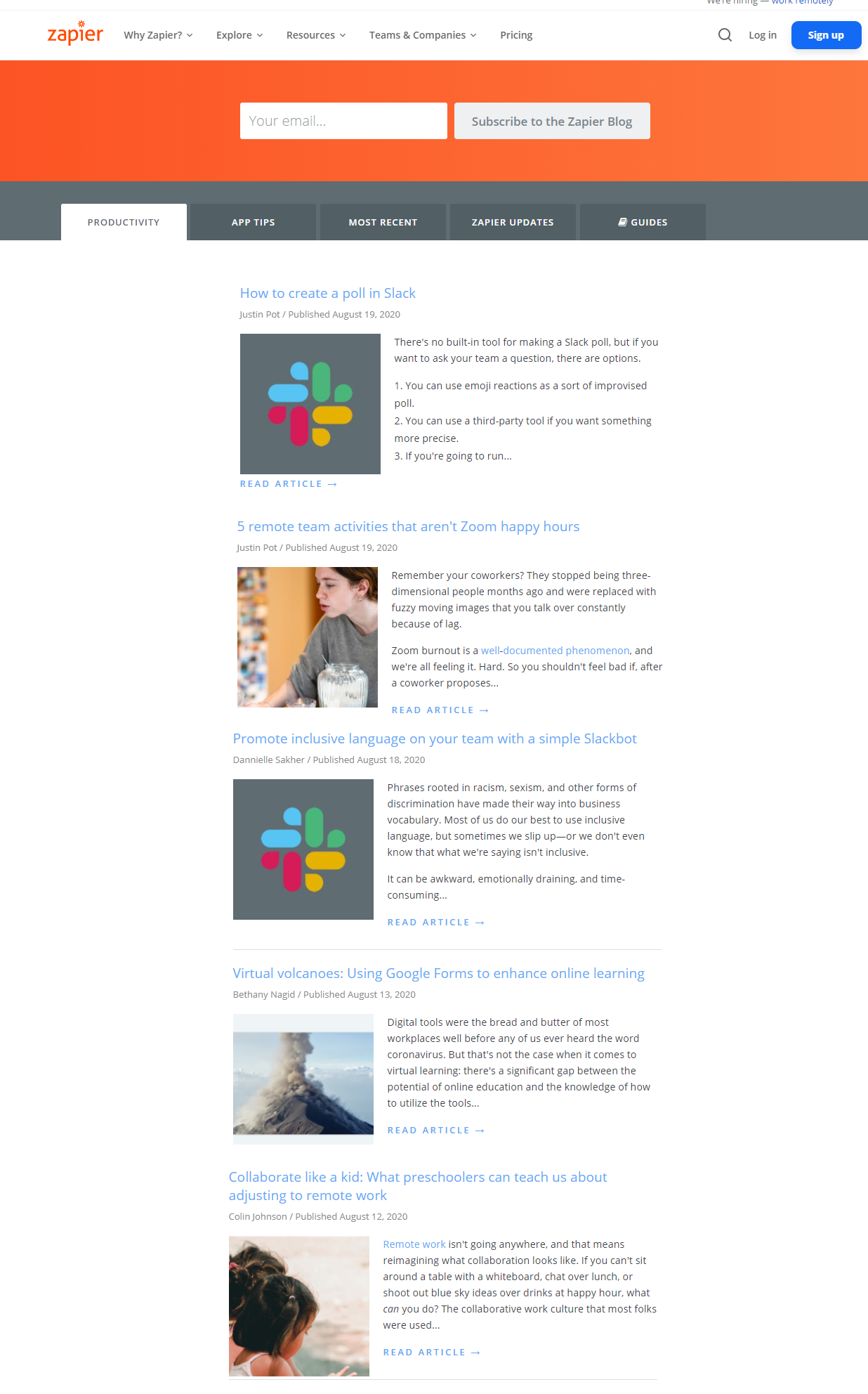
Source: Zapier Website
Building Trust with
Inbound Marketing
Now that the visitors understand what you are selling, they might need a bit more persuasion on "Why you?" among all the competitors. This community you had built are ready to digest more inbound marketing materials, and this is where user-generated content comes in handy.
Honest Testimonials from Clients
You probably have several happy clients that are pleased with the product or service. It would be nice to put their testimonials on the website, so new visitors can see how the community thinks about your brand. These opinions are highly valued nowadays, as they seem less bias and reveal more of the truth on the brand and service than what the marketing team pictures. It gives a realistic touch to how the system helps and how does it apply in real life.
Zapier has created a page called “Customer Stories”, and organized the content showing what apps the customer is using. This help visitor easily finds the content they can relate to. Instead of putting the brand and job titles on the testimonials, they titled each content according to the function they helped on, or the positive outcome. This is much more convincing and relatable for visitors who are looking to solve a problem.

Source: Zapier Website
Getting them on board
The visitors now know why they need the service, and why you are the best. They are ready to get on board!
Free Trial Satisfy their Curiosity
Get the curious bunch of visitors hooked with your service by trying out the system, without a long-term commitment.
For SaaS brands, providing a free trial of their service is a common practice. Some companies might limit the features on a free tier that last for a longer period, while others provide a fuller experience for a shorter time. It depends on your overall marketing plan, the price you are charging, and how your target market behaves.
For Zapier’s example, they provide a 14-day free trial for individual users, at the professional level, which is the 2nd paid level. Letting them try premium features are likely to leave them fascinated with your service, and logically leads to a higher chance of a paid customer in the future.

Zapier pricing tiers for reference. Source: Zapier Website
Attractive Call-to-Actions
The most common way to get attention is through some colourful and attractive words.
Other than interesting and valuable contents, you also need guidance for visitor to go through the intended route for your SaaS inbound marketing process. A Call to Action (CTA) sentence is an inviting way to push visitors on their next step. It gives them a direction on what to do after absorbing the information on the website, which at this stage, is converting from visitors to a subscriber or customer. There should be a CTA for each page to encourage motion and keep them from bouncing off your site, whether it is asking visitors to contact you, to fill in a form, to read another page etc.
Other than the usual “sign up now”, “know more”, “click to learn more”, emphasizing the “free trial” or “try new features” act as an excellent CTA for those ready to get some action.
On Zapier’s website, there are CTA buttons scattered on each page, reminding visitors they have a “14-day free trial”, and they can “sign up for free”. If your visitors are interested, there is a good chance they would subscribe to your newsletter, where you can provide them with more useful content.
Making Use of
Inbound Marketing Materials
We understand that converting the customer has a high cost, and these SaaS inbound marketing materials can be reused in nurturing your customers or subscribers, based on their stage of understanding. Read more about creating content to nurturing your customers and subscribers to maintain a healthy interactive relationship for the long term.
Vision One Digital is experienced in Digital Marketing for SME. Drop us a line if you have any questions or issues on the topic!
